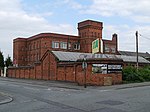St Elphin's Church, Warrington
Anglican Diocese of LiverpoolChurch of England church buildings in CheshireChurches completed in 1354Churches completed in 1867Churches in Warrington ... and 5 more
English Gothic architecture in CheshireEngvarB from October 2013Gothic Revival architecture in CheshireGothic Revival church buildings in EnglandGrade II* listed churches in Cheshire

St Elphin's Church is the parish church of the town of Warrington, Cheshire, England. The church is recorded in the National Heritage List for England as a designated Grade II* listed building. It is an active Anglican parish church in the diocese of Liverpool, the archdeaconry of Warrington and the deanery of Warrington.
Excerpt from the Wikipedia article St Elphin's Church, Warrington (License: CC BY-SA 3.0, Authors, Images).St Elphin's Church, Warrington
Church Street,
Geographical coordinates (GPS) Address External links Nearby Places Show on map
Geographical coordinates (GPS)
| Latitude | Longitude |
|---|---|
| N 53.391 ° | E -2.5799 ° |
Address
Saint Elphin's Church (Warrington Parish Church)
Church Street
WA1 2TL , Howley
England, United Kingdom
Open on Google Maps






